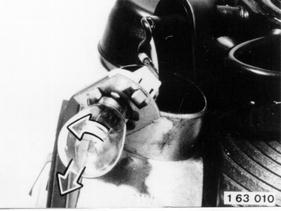GENERAL INFORMATION Disconnecting or Replacing Battery: Take off cover behing the driver´s seat. First unscrew the ground pole terminal and then the positive pole terminal. Unscrew bolts and lift out battery. Important When Disconnecting Battery! Disconnecting the battery will cancel the fault memories of control untis. Consequently first read out fault memories and have any faults printed out. Important With Connected Battery! Working on components, wire connections and so on could cause faults in the fault memories of concerned control units. If jobs in the Repair Manual point out disconnection of the battery, this must always be complied with in the interest of safety. |  |
BATTERY CARE AND MAINTENANCE The electrolyte level of present low-maintenance batteries should be checked annually or at intervals of 25,000 km (15,500 miles) and corrected to the max. mark specified by the battery supplier with distilled water when necessary. Discharging by the power consumption of control units even in standby mode is added to the natural self-discharging of a battery due to the increasing number of control units used in cars today. The batteries of cars in storage should be recharged at the latest every 6 weeks to maintain the service life and avoid excessive discharging. The time for self-discharging depends on the car model and equipment. Charging Battery: If a standard or fast charger (e.g. Bosch SL 2490)* is used to charge a battery, the battery must be disconnected from the electric system and removed in order to avoid damage to paint finish and upholstery by the escaping gas. Excessively discharged batteries could be damaged or destroyed by the very high initial current (high temperature). The battery can remain connected when using an electronic charger (e.g. Siemens VB 801, Gossen 12 V / 30 A)). The electronics does not permit critical peak voltage. An electronic charger also charges an excessively discharged battery with reduced current unit a certain basic voltage is reached. Important! Always first measure the open-circult voltage before charging a battery installed in the car. If this voltage is 10 V or less, it cannot be excluded that one or more cells are faulty or the battery on a whole has already been predamaged. In this case the battery must always be removed and attempt made to regenerate the faulty cells by charging slowly. Remove plugs from the various cells in the interest of safety. Testing Battery: An objective statement on the charged condition of a battery is only possible by way of a load test with cold testing current. This test can be carried out with a battery tester, e.g. Bosch T 12 220* or preferrably with Bosch T 12 200 E*. Additional Information on load tests is contained in the pertinent operating instructions. The acid density of a battery can also be used to determine the charged condition. This test, however, is not as positive due to the design-orientated dispersion range of acid density (e.g. charged standard battery version = acid density 1.28 kg/ltr. - tropic version = acid density 1.23 kg/ltr.). Another interferring factor is the acid layer (fill with distilled water immediately before testing) as well as battery wear with partially sulphated and/or strongly contaminated plates.  * Source of Supply: HWB * Source of Supply: HWB
|